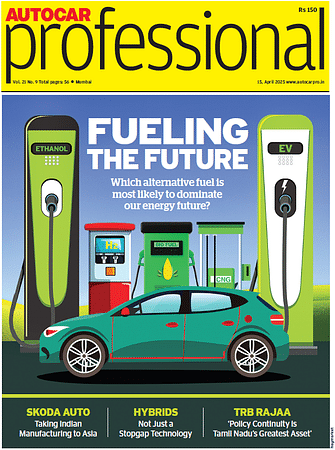Volvo's three-pronged strategy to go fossil free
Maria Ebbesson, head of Volvo’s India R&D Centre, talks about the Swedish automaker’s strategy on electrification, fuel-cells, and alternative fuel powertrains, and the company’s India R&D centre.
Swedish truck-and-bus giant Volvo Group plans to transition to a fully-sustainable heavy commercial vehicle product portfolio by 2040 as part of its plan to completely move away from fossil fuels by 2050.
The company is focusing on alternative fuel technologies, particularly those such as natural gas that are likely to gain traction in markets like India where electrification has been slower to catch on in trucks and buses. The company’s R&D centre in Bengaluru is developing these futuristic powertrain solutions, in addition to its other functions, such as vehicle engineering, software development, as well as executing simulations and virtual product verifications for global projects.
In an interview with Autocar Professional, Maria Ebbesson, VP, Vehicle Engineering, Volvo Group and head of the R&D centre – Volvo's largest outside Sweden – talks about the work carried out in the facility. Excerpts:
How is Volvo progressing towards sustainable mobility globally and what is its approach for India?
With the ongoing shift towards electrification and sustainable mobility, there is a huge transformation currently underway in the automotive industry. From Volvo's perspective, we believe that there is no silver bullet or one technology to achieve sustainability. Rather, we have a three-pronged strategy, wherein we have BEVs, FCEVs, as well as ICE vehicles that will continue to remain important for certain applications and markets for a long time to come.
We have a global sustainability target to become 100% fossil-fuel free by 2050, and given a 10-year average lifespan of our products, we aim to have a completely fossil-fuel free product portfolio by 2040. Although we see strong growth in electrification in India, it is more in the two- and three-wheeler segments, and not so much in the heavy commercial vehicle (HCV) segment.
While markets like the US and Europe are progressing aggressively towards EVs and we have fleets already on the market, India and Asia are advancing more slowly when it comes to electrification in the HCV space. Having said that, we see the Indian market, particularly, to be pushing much more on alternative fuels such as natural and hydrogen gas, and that is where those aspects of our product portfolio fit in very well.
Moreover, it takes much more than just products for successful and widespread adoption of greener mobility solutions. It must be a combination of five factors – products and services, regulations and incentives, infrastructure, greener fuels, and supply chain – for us to offer a wide portfolio of sustainable mobility products.
What are the key activities being undertaken by Volvo at its India R&D centre in Bengaluru?
The R&D centre for Volvo in Bengaluru has all the major development functions – vehicle engineering and technology – undertaking project development for Volvo heavy commercial vehicles globally. The centre executes much of the software development, as well as engineering for electrical architectures and powertrain, and focuses on electromobility for innovating on sustainability.
In terms of safety, the centre is developing both active and passive safety solutions for Volvo products, regardless of whether they are sold in India or overseas markets. Furthermore, we are already seeing the safety functions in vehicles become more advanced as well as important. For instance, while front under-run protection and pedestrian crash-safety requirements have become extremely important with respect to the passive safety of a vehicle, ADAS features such as autonomous emergency braking are also gaining momentum to assist the driver in preventing a critical accident.
What is Volvo Group and Daimler Truck's vision under the recently announced binding agreement for SDVs?
We are seeing the software-defined vehicle (SDV) shift in CVs as well, and it is more about bringing the complete end-to-end experience to the end customer. There are several parameters such as fuel efficiency and vehicle route that can be optimised with an SDV architecture in a commercial vehicle. With Volvo Group's joint venture with Daimler Truck, the idea is to come together on the development of the base, high-volume, high-capacity ECUs and electrical systems, which, while critical for the vehicle, are not core from an end-customer's perspective.
Therefore, such synergies allow us to come together to work better with our suppliers, share development solutions, and eventually bring better solutions for our customers, while each company focuses on their respective brand ethos and offering unique products.
What role is being played by Digital Twins, Artificial Intelligence (AI) and Machine Learning (ML) in vehicle engineering at Volvo?
We are working on digital twins in several aspects, particularly for product development as well as virtual validation. We are also using artificial reality (AR) and virtual reality (VR) tools together with digital twins to replicate trucks and buses in the digital world, both for our product development purposes and for the aftermarket initiatives out in the field.
For instance, we recently introduced a mobile safety application to assist emergency responders for Volvo's all-electric heavy commercial vehicles. It is here that by using digital twins, the technicians would remotely get the relevant information and exact vehicle details such as the location of its power system, as well as the step-by-step instructions to shut it down in case of an emergency or accident.
Volvo's overall ambition is to be 100% safe, 100% fossil-free and 100% more productive, and digital transformation is a key enabler of these goals. And that holds true not just for what we do but also the products that we sell and how we produce them. We are leveraging digital transformation for becoming more agile and strengthening our new product development, manufacturing, and supply chain.
Furthermore, AI helps us to handle and analyse the multitude of data that we source from around the vehicle, or from conducting various tests and validations, in a very efficient manner. AI helps us analyse the various situations and scenarios by executing simulations to undertake faster development loops.
How is Volvo looking at sustainability holistically from an engineering standpoint?
There are two aspects to sustainability – the product itself, its application and the fuel being used – and secondly, how products are manufactured, the components being used, and the materials being deployed, along with a sustainable logistics channel. At Volvo, we are working in all these different aspects by adopting several measures, such as using renewable materials for our components and ensuring an increasing reliance on green energy during the overall manufacturing process of the vehicle as well as its components. We are also focusing on making the entire logistics chain as close to net-zero CO2 as possible.
What is your vision for Volvo Group's India R&D centre by 2030?
The India R&D centre in Bengaluru is Volvo Group's largest development centre outside Sweden. We already play a major role in global product development, we will continue to do so in the coming years as well. We have a 1,500-member strong workforce at this centre that is involved in complete vehicle engineering, majorly for global markets, but is also supporting our local manufacturing in India and our local customers as well.
Moreover, while we have a very strong resource foundation at the R&D centre, we also have a robust talent ecosystem in terms of our collaborations with universities to ensure students are ready and well equipped for working in the automotive industry when they graduate. Thus, we will continue to be strong and continue to build upon our strengths, be it in the areas of virtual and software development, simulations, or verifications.
RELATED ARTICLES
'India Can Become a Major Pillar for Us' - Marquardt Group
Björn Twiehaus, CEO of Marquardt Group, and Vishal Narvekar, the company's India GM, share their outlook on the Indian m...
Luxury Car Market to Slow in 2025: Mercedes-Benz Sees Flattish Numbers
In Jan to March of 2025, the market may witness its slowest growth since COVID-19, and if the weakness continues, the se...
‘We Must Have More Women Leaders in the Auto Sector:’ Anjali Rattan
The chairperson of the New Delhi-headquartered RattanIndia Enterprises believes that with their multi-tasking nature, wo...






 26 Nov 2024
26 Nov 2024
 5254 Views
5254 Views





 Darshan Nakhwa
Darshan Nakhwa


 Prerna Lidhoo
Prerna Lidhoo


